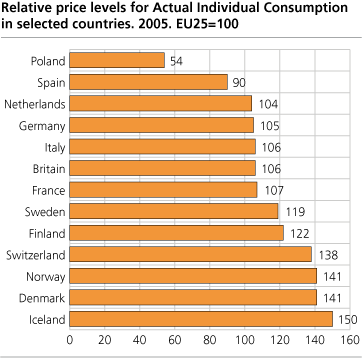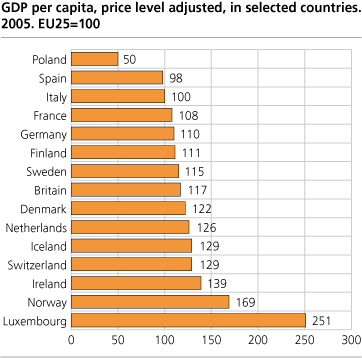Content
Published:
This is an archived release.
Stable price level differences across Europe
The price level differences across Europe were comparatively stable in the period 2003-2005. Denmark, Iceland, Norway and Switzerland had Europe's highest price levels, whereas the new EU member states in Central Europe, as well as Bulgaria, Macedonia, Romania and Turkey, came out at the bottom.
These are among the conclusions that can be drawn based on the European Purchasing Power Survey for 2003, 2004 and 2005. The figures were recently released by Eurostat. In spite of Norway's high price level, the country's Gross Domestic Product (GDP) per capita is one of the highest in Europe.
2005: Iceland on top
In 2005, the price level of goods and services for actual individual consumption was 41 per cent above the EU average in both Denmark and Norway. This is 18 per cent ahead of Sweden, and 15 per cent above Finland's level. Switzerland's price level was similar to Norway's, while Iceland came out on top, with a price level 50 per cent above the EU average.
Among the 12 countries that have introduced the euro, considerable price level differences prevail. For instance, the price level in Ireland and Finland is 40 per cent higher than in Portugal and 47 per cent higher than in Greece. For the 25 EU member states as a whole, the variation across countries is even more remarkable: Denmark's price level is three times higher than Lithuania's. The four largest EU economies, France, Italy, the UK and Germany, all have very similar price levels, about 25 per cent below Norway's.
The distinction between the 15 "old" EU countries and the new member states in Central Europe is still remarkable. In several of the Central European countries, the price level is about one half of that in the former EU15. From 2003 to 2005, however, there seems to be a certain move in the direction of a more homogenous European price level.
Exchange rates important
It is important to be aware that exchange rates have a large impact on international price level comparisons. One good example of this is the case of Iceland. From 2004 to 2005, Iceland established itself as Europe's most expensive country, well ahead of Denmark, Norway and Switzerland. However, this development is not an effect of higher inflation in Iceland than in its partner countries, but is rather due to the appreciation of the Icelandic krona. Similarly, Norway's relative price level went down from 2003 to 2004, but re-established itself at the 2003 level the following year, due to exchange rate fluctuations. A weaker krone in 2004 made Norway cheaper from a foreign perspective.
The euro countries share a common currency, and consequently, there are no exchange rate movements that affect the comparison of relative price levels. Not surprisingly, the price level differences among these countries seem relatively stable over the years 2003-2005.
Price levels and income levels
In an international comparison of material living standards, we need at least a comparable measure of income like, for instance, GDP per capita, and price level indicators that enable us to take price level differences across countries into account.
In a European comparison of price level adjusted GDP per capita, Norway comes out second, 69 per cent above the EU25 average. This is 38 per cent higher than Denmark and 47 per cent ahead of Sweden. Luxembourg is the only country that comes out ahead of Norway, while other high-income countries include Ireland, Switzerland and Iceland. Together with Estonia, Latvia, Lithuania, Romania and Turkey, Norway is one of the countries with the highest year-on-year increase in price level adjusted GDP per capita in the years 2003-2005.
Within the EU, there are still very considerable differences with regard to countries' GDP per capita. Even after accounting for differences in price levels, most of the new member states in Central Europe come out between 20 and 50 percent below the current EU average.
See Eurostat's dissemination database for more figures.
Tables:
- Table 1 Relative price levels for GDP and Actual Individual Consumption. Price level adjusted GDP per capita. 2003. EU25=100
- Table 2 Relative price levels for GDP and Actual Individual Consumption. Price level adjusted GDP per capita. 2004. EU25=100. Preliminary figures
- Table 3 Relative price levels for GDP and Actual Individual Consumption. Price level adjusted GDP per capita. 2005. EU25=100. Preliminary figures
This page has been discontinued, see Comparison of price levels in Europe, Annually.
Additional information
Contact
-
Birte Larsen Sandstå
E-mail: birte.sandsta@ssb.no
tel.: (+47) 92 60 56 03
-
Hamdi A. Mohamed
E-mail: hamdi.mohamed@ssb.no
tel.: (+47) 46 81 54 76
-
Norway-ppp@ssb.no
E-mail: norway-ppp@ssb.no


